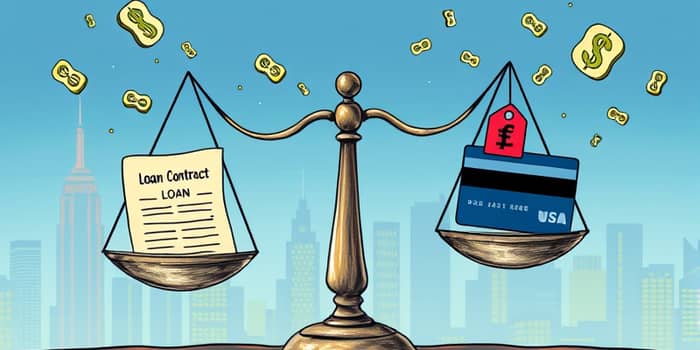
In today’s complex financial landscape, choosing between borrowing options can transform uncertainty into opportunity. This guide dives deep into the fundamental contrasts between loans and credit cards, helping you unlock structured and predictable repayment schedule that suits your needs and ambitions.
At the core, a personal loan represents installment credit with fixed payments, delivering funds as a one-time amount repaid over a set period. Borrowers receive a lump sum ranging from $1,000 to $100,000, typically over 1–7 years, with a fixed interest rate that remains consistent throughout the term.
Credit cards, by contrast, offer revolving line of credit access. You have continuous borrowing power up to your credit limit, which you can tap via swipes or online purchases. Payments are flexible—you pay at least a minimum each month—but the rate can fluctuate with market conditions.
Interest rates and fees can make or break a borrowing decision. Personal loans generally come with lower and fixed interest rates, often ranging from 6% to 36% APR based on creditworthiness. Credit cards typically carry higher average APRs—20% to 25%+—unless you pay your full balance each month or secure a 0% introductory offer.
Understanding the fee structures is equally important. Loans may include origination fees of 1–8%, prepayment penalties, and late fees. Credit cards can charge annual fees, balance transfer costs (3–5%), late payment fees, and cash advance fees.
Loans enforce structured and predictable budgeting, simplifying your monthly planning. Once approved, you cannot borrow more from the same loan. Early repayment may incur fees, though some lenders waive prepayment penalties.
Credit cards shine for maximum financial flexibility and rewards potential. You can borrow, repay, and borrow again at will. Paying in full each month avoids interest, but carrying balances invites high costs over time.
Choosing wisely means weighing upsides and downsides with honesty.
Personal Loans — Pros:
Credit Cards — Pros:
Despite these advantages, both come with caveats. Loans lack flexibility after disbursement and often impose origination fees. Credit cards tempt overspending, and temptation to overspend and accumulate balances can trap you in costly cycles if only minimums are paid.
If you face a planned, substantial expense—home improvement, wedding, or consolidating high-interest debt—a loan’s one-time lump sum disbursement and fixed-term structure can provide stability. You’ll know exactly how much to pay each month and when the debt will be fully settled.
For debt consolidation, converting revolving credit card balances into a loan with a potentially lower rate can reduce overall interest and simplify payments. This approach also helps diversify your credit history effectively.
For ongoing, unpredictable costs—groceries, fuel, travel—a credit card’s agility is unmatched. The ability to earn rewards on everyday spending can offset expenses over time. Emergency surprises are more manageable when you have strict budgeting and repayment discipline needed to clear balances each month.
Zero-percent APR promotions can be a strategic short-term tool. By paying off balances before the introductory period ends, you effectively borrow interest-free, often with just a modest balance transfer fee.
Both tools can enhance your credit mix when managed responsibly. On-time payments demonstrate reliability and lower utilization ratios. Conversely, missed payments or maxed-out cards can drag your score down quickly. A well-structured personal loan can improve your credit mix, while prudent credit card use maintains healthy utilization.
Ultimately, the choice between a personal loan and a credit card boils down to your unique circumstances and financial habits. Align your borrowing strategy with your goals—be it debt consolidation for long-term savings or ongoing access to emergency funds. Thoughtful planning, disciplined repayment, and a clear understanding of terms will empower you to make the best financial decision and steer your finances toward lasting stability.
References













